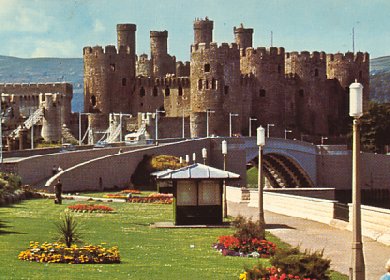 Conwy Castle
Built between 1283 and 1289, the Castle is now looked after by CADW. Picture taken from my collection of old postcards.
Conwy Castle
Built between 1283 and 1289, the Castle is now looked after by CADW. Picture taken from my collection of old postcards. |
|
Historical Sites Nearby
Within 10 miles of Bangor are the Roman Fort of Segontium at Caernarfon. The World Heritage site lists the magnificent Edward 1st Castles at Beaumaris, Caernarfon and Conwy. Inland are the Princes' of Gwynedd fortresses at Dolbadarn near Llanberis and at Dolwyddelan.
|
|
Port Penrhyn and slate
When the slate industry in Snowdonia was booming Bangor was a major seaport sending slate all over the world. The evidence for this can still be seen on the quayside and at Penrhyn Castle. The University was built with money donated by the families of the Penrhyn Quarry and the quarry is still operative today.
Click here for a link to the University website
About Penrhyn Castle
Penrhyn Castle dates back to the times of Ednyfed Fychan, distain to Prince Llywelyn the Great. Richard Pennant (1737? -1808), was the first person to set the slate industry on its entrepreneurial phase. His steward William Williams (1738-1817) should be given the credit for suggesting the development of galleries in the Penrhyn Quarry to Pennant. William Williams ran the quarry on a business basis, thus changing permanently the infrastructure of almost the whole slate industry. On Lord Penrhyn’s death in 1808, and his widow in 1816, the Penrhyn estate went to George Hay Dawkins (1763-1840) his cousin, who inherited the whole estate and also the Jamaica plantations. He started expanding the estate by purchasing various parcels of land, and also bought most of the hotels in the city of Bangor. He was responsible for the present building which dates to 1827, built to the plans of Thomas Hopper, one of the leading architects of the day.
Edward Sholto Douglas-Pennant, 1864-1927 (third Baron Penrhyn of Llandygai) had to sell parts of the estate tp pay death duties in 1907, and more sales took place in the following years. Hugh Napier Douglas-Pennant, (1894-1949) was also forced him to sell property to pay death duties. The Jamaica estates were sold in 1933 followed by more property in Caernarfonshire in 1939. On his death in 1949, the title and estate were split. His niece, Lady Janet Douglas Pennant (1923-97) inherited Castell Penrhyn, the quarry and the estate. Two years later she agreed with the Treasury to transfer Castell Penrhyn and a large part of the estate to them in lieu of death duties. In turn, the Treasury transferred them to the National Trust.
The National Trust webpage for Penrhyn
|
 A slate roof
A slate roof
Slate can be used to make roofs, walls, driveways, flights of steps |
